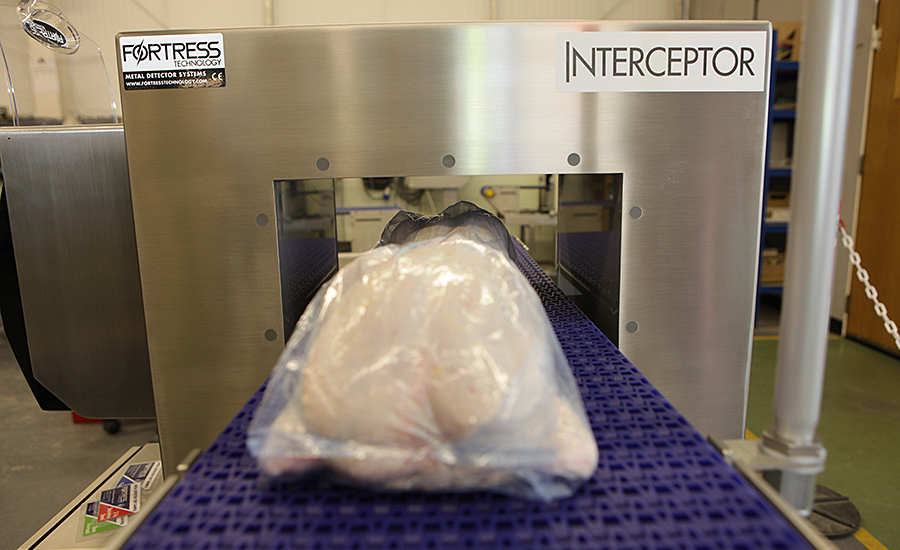Fortress Technology examines the different factors that are accelerating the need for smarter systems, and how intelligent inspection equipment is helping to usher in a new era of food safety.
Beyond identifying contaminants, smarter technology is being used within or alongside inspection systems within industrial meat processing to improve efficiency, compliance and, ultimately, profitability. The U.S. Food and Drug Administration (FDA) has addressed these changes with its New Era of Smarter Food Safety. Building upon its Food Safety Modernization Act (FSMA), the initiative offers a new approach to food safety that involves leveraging technology and other tools to create a safer and more digital, traceable food system. Rather than relying on largely paper-based systems, the digital process facilitates swifter responses. In addition to offering advice on how to implement tech-enabled traceability, the FDA’s blueprint outlines the need for smarter tools and approaches for prevention and outbreak response, new business models and retail modernization and food safety culture.
Digital testing for greater traceability
As the global food supply chain grows increasingly complex, the FSMA has shifted focus from response to prevention and is driving the adoption of track-and-trace technologies in all sectors. Despite stricter regulatory measures to prevent physical hazards from occurring, recall incidents increased in the U.S. by ten percent between 2013 and 2018, a major contributing factor linking a rise in physical contaminants, including metal, glass and plastic. Understanding how to optimize metal detection systems is not just good business practice, but it also forms a critical part of the planning for a recall process. The speed at which a meat processor can publicly pinpoint the source of a contaminant is imperative and can minimize the damage caused by a recall. While inspection systems such as metal detectors and x-ray are an integral first step in quality control, proper management with regular testing is vital to ensure optimum protection is achieved. In its blueprint, the FDA discusses the feasibility of remote, virtual, and/or component inspections of foreign and domestic firms. This principle can be applied to the testing process of metal detectors and x-ray machinery too. Automatic digital testing technology, for example, is starting to gain industry acceptance and allows for tests and records to be activated automatically and even remotely if required. Leveraging digital concepts for this critical step in food safety compliance provides meat processors with a true measure of how each inspection machine is performing. In many liquid, paste and soft meat applications, pipeline systems typically provide a better performance. However, testing the performance of a pipeline metal detector is made difficult due to access, machine position, product flow and environmental conditions. Testing interoperability not only removes the risk of human error, but also significantly reduces labor costs and safety hazards associated with manual checks.

The interceptor was inspired by difficulty in inspecting “wet” products or those wrapped in metalized film
The future of metal detection technology
To fully realize the prevention-based framework set out by the FSMA, consideration must be given to make processes more effective and efficient. As much as meat processors must adopt inspection equipment with improved sensitivity levels, an equally important criterion is to eliminate false rejects. Each type of meat – ground, large joints, cooked, frozen, etc. – have varying product effects and therefore behave differently in a metal detector. Additionally, if each item is individually wrapped, then the overall packaging may be thicker or have effects of their own, which can potentially limit or adversely affect the performance of a metal detector. A metal detector that can run multiple frequencies simultaneously, is ideal for these type of meat products, as it can accurately inspect on a wider spread of products with varying effects.
Identifying metal within conductive meat products can involve changing the frequency to minimize the effect. However, this can have a devastating impact on the accuracy of a detector, as operators might lower the sensitivity to the point where contaminants pass through. Alongside eliminating the risk of false rejects and ensuring high sensitivity, in-built automatic product tracking and data capture software will further increase transparency and traceability. Advanced new systems with data collection and paperless test routines will become more prevalent moving forward. For example, manufacturers might opt for a combination metal detector and checkweigher capable of pre-configuring every test by retailer code of practice and product being inspected.
Accelerating automation investments
For new-generation meat processors embracing the digital revolution, automation is critical when it comes to targeting operational inefficiencies and reducing product and packaging waste. Prompted by labor issues during the pandemic, many meat processors in North America have already started to expedite their automation investment plans.
When it comes to adopting smarter technologies and approaches, it is not wise to pit metal detection and x-ray against one another. Depending on the application, both have a place in a meat processor’s production line. Metal detection is most common, as metallic inclusions are the number one contaminant. However, X-ray can be used as a complementary technology providing the opportunity to detect some non-metal contaminants. e.g. calcified bones, and provides other product analysis features (for example fat content).
Factory layouts and the placement of inspection machinery is, as always, an important consideration. When working together, an x-ray system will tend to favor an in-line position, whereas metal detectors are better located towards the end of the processing line, often after meat has been packaged.
It is never worth replacing a metal detector with an x-ray machine, as users will lose ‘virtually all detection’ of low density metals unless a ‘very large chunk’ presents itself. Additionally, while x-ray machines are built to withstand water, they don’t like it around them. Similarly, dust, heat and cold temperatures will shorten an x-ray’s life span, or at least their components.
There is a heightened demand for faster, more-versatile and hygienic inspection systems, as meat and poultry processors are facing increasing demand from retailers to provide products in different packaging styles and sizes. Additionally, digitized processes are being more widely adopted as meat processors build sturdier supply chains. As these grow increasingly complex, it is becoming even more imperative to work closely with a solution provider who can help you to maximize the benefits of your equipment and keep pace with an ever-changing industry.
For more information, visit www.fortresstechnology.com.



Report Abusive Comment